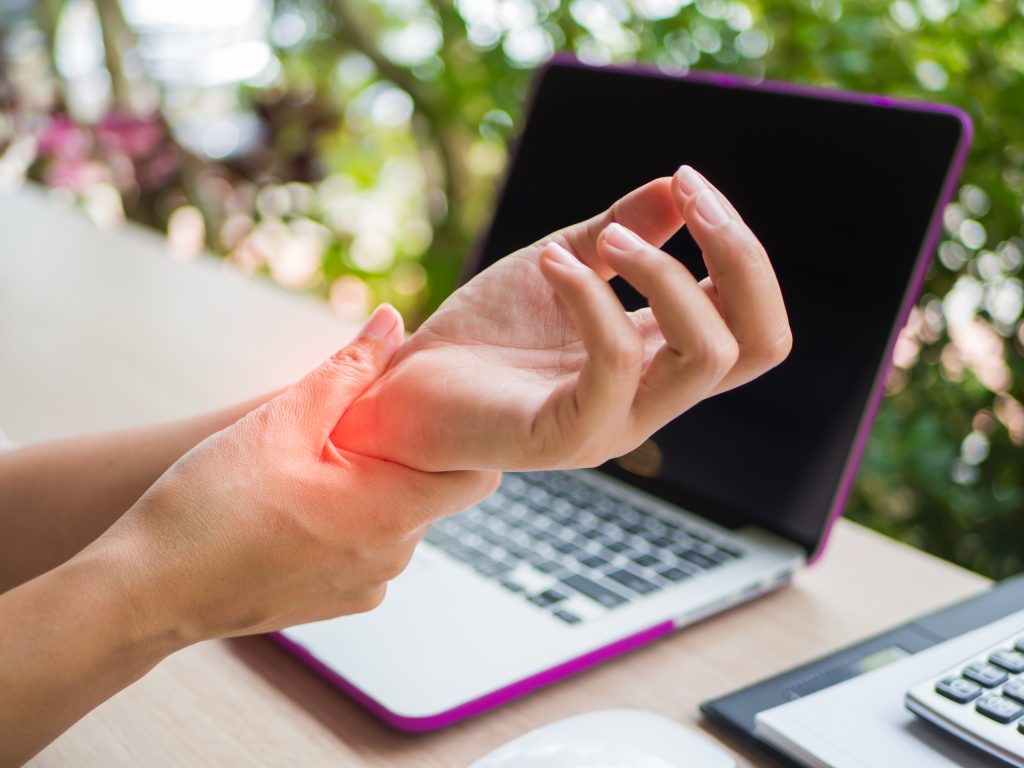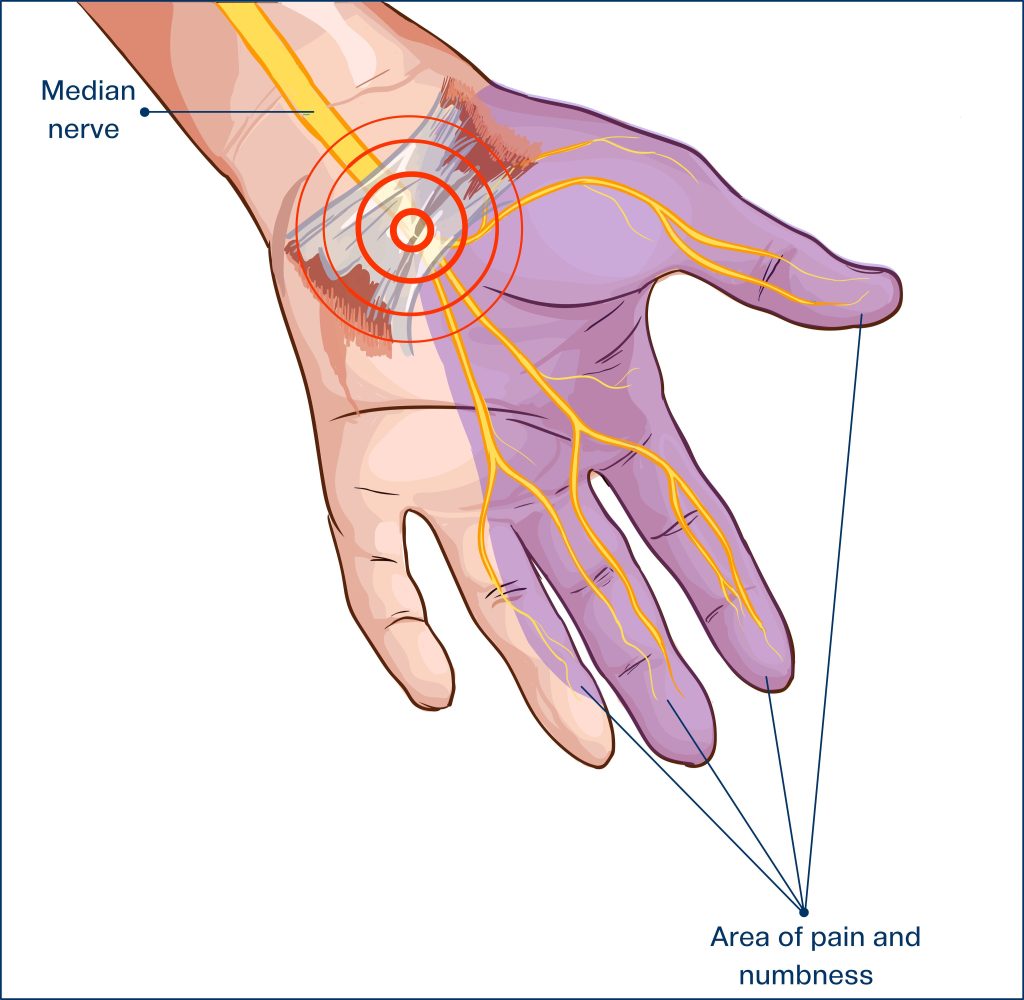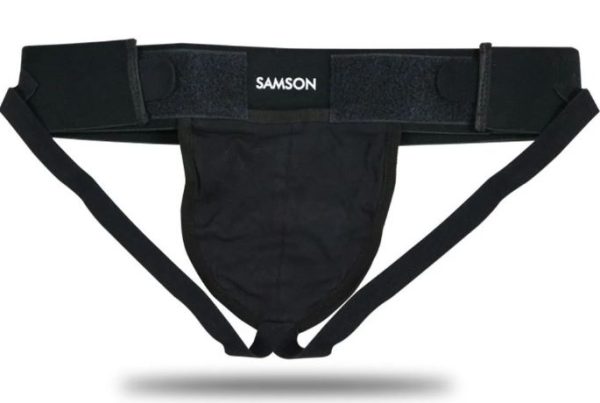
It is common for us to take our hands for granted. But for those who suffer from carpal tunnel syndrome, even the simplest tasks can be a challenge.
A condition called carpal tunnel syndrome affects the wrist and hands. Pressure on the median nerve, which runs from the neck to the hand, causes carpal tunnel syndrome. This disorder can seriously affect your life.
This condition can have a wide range of symptoms and develop gradually. Left untreated can lead to nerve damage, making the affected hand numb and weak. Treatments are available to relive the symptoms of carpal tunnel syndrome.
Basics of CTS

A person with carpal tunnel syndrome has nerve compression in the forearm. This nerve travels through the carpal tunnel on its way to your fingers. When you use your hands too much and put pressure on them, it can cause swelling within the carpal tunnel. The median nerve becomes swollen, increasing pressure on it. The result of this would be carpal tunnel syndrome.
You receive sensation from the median nerve to your thumb, index finger, middle finger, and half of your ring finger. It also supplies part of your palm and some small muscles in your hand.
Symptoms of CTS
Symptoms of carpal tunnel syndrome vary from person to person but usually include:
- Pain in the hands or wrists (usually worse at night).
- Tingling or numbness in the hands or fingers while they’re resting on a hard surface like a table or desk.
- Loss of grip strength.
- Difficulty with fine motor tasks like writing or buttoning clothes.
- Clicking or popping sounds that come from your hands when you move it.
- Weakness in one hand compared to the other hand (usually noticeable when using objects like pens).
The risk of developing carpal tunnel syndrome has increased over time because of changes in our lifestyle and work habits. Our use of computers and other electronic device has led to more repetitive-stress injuries in recent years. These activities can put pressure on the nerves inside of our wrists, causing them to become inflamed.
Determining the cause of CTS
Carpal tunnel syndrome occurs as a result of several factors, among which are:
- Repetitive motion (like typing).
- Injury to the wrist.
- Being overweight or obese.
- Prolonged periods of immobility (like sleeping).
- Age (people over 40 are more likely to develop carpal tunnel syndrome).
How to diagnose CTS
If you have carpal tunnel syndrome, you can do a few things to diagnose it. First, pay attention to how your hands feel after a hard day of typing or other repetitive motions. Do they feel tingly or numb? Do the joints in your fingers seem stiff or sore? If so, you might have carpal tunnel syndrome.
Suppose you’ve been experiencing pain in your hand or wrist for several weeks. In that case, you must discuss the possibility of carpal tunnel syndrome with your doctor. You may be asked about the symptoms you exhibit during physical examination.
Suppose your doctor suspect you have the condition, they may order an electrodiagnostic test known as EMG/NCV. EMG measures electrical activity in the muscles. NCV measures the speed of electrical impulses along your nerves.
Some people have mild symptoms that don’t affect their daily activities. Others may need surgery to relieve pressure on the median nerve.
How to treat CTS
Various treatment options are available for carpal tunnel syndrome, including:
Medication: Doctors may prescribe medicines for pain and inflammation. This medication should help manage the symptoms of your carpal tunnel syndrome.
Corticosteroid Injections: These steroid injections reduce inflammation in the area around your nerves. Long-term use is not recommended, even if they are very effective at easing pain.
Surgery: If you do not respond to conservative treatment, surgery might be the best option. This option includes people with sever CTS that do not improve with time.
Physical Therapy: This option is best for people with mild CTS. Physical therapy can help patients learn how to manage their symptoms. It helps improve mobility and range of motion in the hands by stretching and strengthening them. Furthermore, it relieves inflammation and swelling in the carpal tunnel.
Splints: Wearing a splint helps reduce pressure on the median nerve. Also, it keeps your wrist in a neutral position to avoid making things worse. Splints are usually worn at night or day to help reduce pain and swelling.
Physical Therapy Modalities
Physiotherapists can help treat carpal tunnel syndrome by increasing flexibility in your wrists. It also allows you to learn exercises to help relieve symptoms and prevent injury. Physiotherapists can combine these therapies for a more effective treatment plan.
Ice Therapy helps reduce swelling in the wrist, which can relieve pressure on the nerves. Some people prefer to use ice or cooling gel packs, or even ice gels.. This treatment involves applying an ice pack to the wrist for 15 to 20 minutes. It would be best to wrap an ice pack in a towel or cloth instead of directly on the skin. In the acute stage of CTS, ice therapy is most effective.
On the other hand, heat therapy is most useful for chronic carpal tunnel syndrome. Heat therapy helps relax muscles. It also increases blood flow to areas with inflammation, reducing pain and swelling. Daily heat treatment usually lasts 10 to 15 minutes.
A paraffin wax bath involves soaking your hands in warm wax and wrapping it in a towel for 15-20 minutes. Your therapist uses a paraffin wax bath machine to heat the wax at a specific temperature. Applying heat to the hands can help to decrease inflammation and swelling. It also helps relieve pain and numbness in the hands.
One treatment option is low-level laser therapy (LLLT). During the procedure, blood flow increases by stimulating fibroblasts. Fibroblasts are responsible for producing collagen. Physiotherapists may combine other treatments with this procedure. The treatment typically takes about 15 minutes per day over three weeks.
One new form of therapy that’s currently being discussed is the use of ultrasound therapy for CPT. While this is still in the research stage, it does bring hope for another effective kind of non invasive therapy for long suffering patients.
Physical Therapy Exercises
Tendon gliding exercise: There are two ways to perform tendon gliding exercises.
- To make a fist, keep your hand in front of you and your wrist straight. Point all your fingers up, and then wrap your thumb around them to make a tight fist.
- Fully straighten all your fingers. Bend your fingers at the bottom knuckle and keep them straight to create a table top. Bend your fingers at the middle joint, touching them to your palm.
Perform these exercises once or twice daily. Move from position 1 to 3 in sequence and hold each position for three seconds. Click here for a detailed information about this exercise.
- Make a fist.
- Make sure your fingers are extended as much as possible.
- Keep your thumb close to the side of your hand.
- Bend your hand backward toward your forearm.
- Keep your fingers straight and extend your wrist.
- Make sure your thumb is the only thing extended in this position.
- Extend your fingers, wrist, and thumb, and turn your forearm palm up.
- Using your other hand, gently stretch out your thumb.
To perform wrist extension exercise, straighten out your fingers and keep your arm bent at a 90-degree angle. In this exercise, you should feel some stretch in the back of your forearm and hand. Hold this position for 20 seconds, then release. Repeat five times.


To perform wrist flexion exercise:
- Hold your wrist straight out in front of you and bend your wrist forward toward your thumb. It should feel like there is a stretch in your forearm.
- Hold this position for 20 seconds, then release.
- Repeat five times.
Prevention
You can reduce your symptoms by taking measures to prevent further damage to your wrist. Here are some tips:
- Use ergonomic keyboards or mouse devices that keep your wrists in a neutral position while typing or clicking.
- Use a mouse with fewer buttons, so you don’t have to stretch your fingers as much when clicking!
- Take frequent breaks- at least 15 minutes if possible. Always do some light stretching before resuming work.
- Make sure your chair has adequate support for both feet and back.
Conclusion
Carpal tunnel syndrome can be a life-changing issue. Thus, you need to understand its symptoms and how they affect you to get the proper treatment in time.
Any time you notice any of the symptoms stated above, seek immediate help. In some cases, carpal tunnel syndrome may take months before it completely disappears. When any of these symptoms persist over two weeks or more, make an appointment with your doctor. Remember” Early diagnosis leads to faster recovery!



